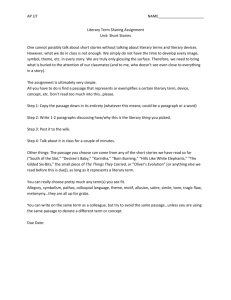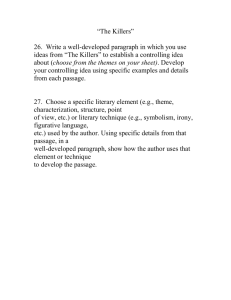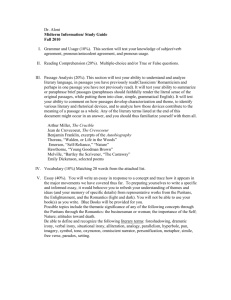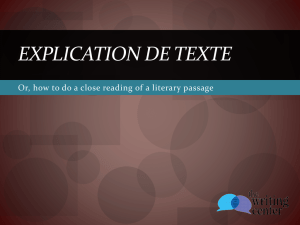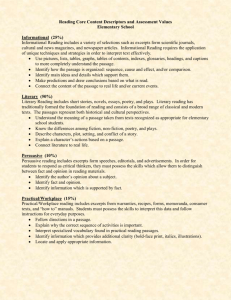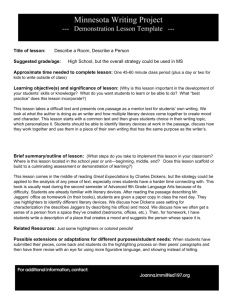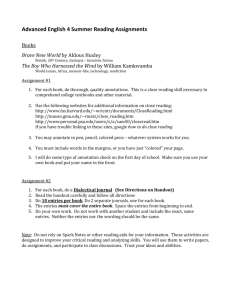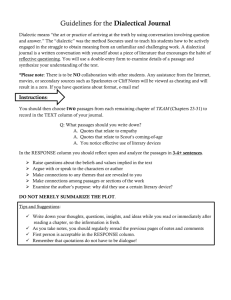AP Summer Reading Dialectical Journal Assignment
advertisement
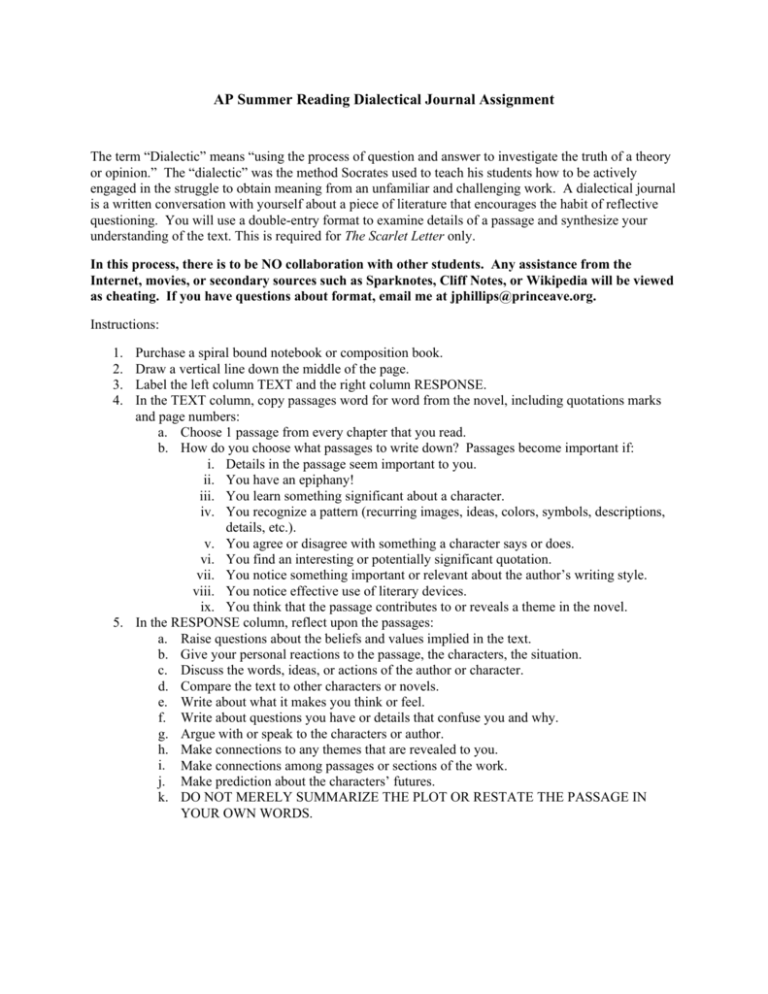
AP Summer Reading Dialectical Journal Assignment The term “Dialectic” means “using the process of question and answer to investigate the truth of a theory or opinion.” The “dialectic” was the method Socrates used to teach his students how to be actively engaged in the struggle to obtain meaning from an unfamiliar and challenging work. A dialectical journal is a written conversation with yourself about a piece of literature that encourages the habit of reflective questioning. You will use a double-entry format to examine details of a passage and synthesize your understanding of the text. This is required for The Scarlet Letter only. In this process, there is to be NO collaboration with other students. Any assistance from the Internet, movies, or secondary sources such as Sparknotes, Cliff Notes, or Wikipedia will be viewed as cheating. If you have questions about format, email me at jphillips@princeave.org. Instructions: 1. 2. 3. 4. Purchase a spiral bound notebook or composition book. Draw a vertical line down the middle of the page. Label the left column TEXT and the right column RESPONSE. In the TEXT column, copy passages word for word from the novel, including quotations marks and page numbers: a. Choose 1 passage from every chapter that you read. b. How do you choose what passages to write down? Passages become important if: i. Details in the passage seem important to you. ii. You have an epiphany! iii. You learn something significant about a character. iv. You recognize a pattern (recurring images, ideas, colors, symbols, descriptions, details, etc.). v. You agree or disagree with something a character says or does. vi. You find an interesting or potentially significant quotation. vii. You notice something important or relevant about the author’s writing style. viii. You notice effective use of literary devices. ix. You think that the passage contributes to or reveals a theme in the novel. 5. In the RESPONSE column, reflect upon the passages: a. Raise questions about the beliefs and values implied in the text. b. Give your personal reactions to the passage, the characters, the situation. c. Discuss the words, ideas, or actions of the author or character. d. Compare the text to other characters or novels. e. Write about what it makes you think or feel. f. Write about questions you have or details that confuse you and why. g. Argue with or speak to the characters or author. h. Make connections to any themes that are revealed to you. i. Make connections among passages or sections of the work. j. Make prediction about the characters’ futures. k. DO NOT MERELY SUMMARIZE THE PLOT OR RESTATE THE PASSAGE IN YOUR OWN WORDS. Include the following in your responses: 6. 7. 8. 9. 10. l. Record questions you have or details that confuse you. m. (R) Reaction – Describe what the passage makes you think or how it makes you feel and why. n. (C) Characterization – Analyze details or dialogue uses to show you aspects of the identities of the characters. o. (CO) Connection – Make connections to other places in the novel or to your life, or to the world, or another story that you have read. p. (P) Prediction – Anticipate what will occur based on what is in the passage. q. (LD) Literary Device – analyze the author’s writing using literary terms. r. (RE) Reflect – Think deeply about what the passage means in a broad sense – not just to the characters in the story. What conclusions can you draw about the world, about human nature, or just about the way things are? s. (T) Theme – Determine the passage contributes to the author’s overall message or messages about some aspect or aspects of life. t. (M) Mood – Determine the way the passage establishes the mood or tone of a scene and explain how that might be important. u. (Q) Ask questions about what is happening, what a detail might mean, or things you are curious about. v. DO NOT JUST SUMMARIZE THE PLOT OR RESTATE THE QUOTE IN YOUR OWN WORDS. i. IMPORTANT: it is important to always explain why you think something or like something or don’t understand something. Each TEXT entry must be at least 30 words. Each RESPONSE must be at least 90 words (include word count at the end of each response). Write down your thoughts, questions, insights, and ideas while you read or immediately after reading a section of the book so the information is fresh. As you take notes, you should regularly re-read your previous pages of notes and comments. First person writing (using the pronoun “I”) is acceptable in the RESPONSE column. Remember the quotations in the TEXT column do not have to be dialogue! Sample Journal Entry TEXT “The puddle had frozen over, and me and Cathy went stompin in it. The twins from next door, Tyrone and Terry, were swingin so high out of sight we forgot we were waitin our turn on the tire. Cathy jumped up and came down hard on her heels and started tapdancin. And the frozen patch splinterin every which way underneath was kinda spooky. ‘Looks like a plastic spider web,’ she said. ‘A sort of weird spider, I guess, with many mental problems’” (35). RESPONSE (CH) In this first paragraph of the story, Bambara indirectly characterizes the narrator using rural Southern dialect to let us know that the story is set in the South and our narrator is not necessarily educated. We also learn that the characters are children from the activities the author describes. I also like the imagery (LD) of the puddle freezing over, which I guess also lets us know that it is winter. I also really like the imagery of the splintering puddle and the “tapdancin.” (M) The writer seems to be establishing a humorous and lighthearted mood at the beginning of the story. I wonder ifthe mood will stay lighthearted. (110) Grading: A = Meaningful passages, plot, and quotation selections. Thoughtful interpretation and commentary about the text; avoids clichés. Includes comments about literary devices such as theme, narrative voice, point of view, imagery, conflict, symbols, etc., and how each contributes to the meaning of the text. Makes insightful personal connections and asks thought-provoking questions. Coverage of text is complete and thorough. Journal is neat, organized, and professional looking; student has followed all directions in creation of journal. B = Less detailed, but significant, meaningful plot and quote selections. Some intelligent commentary; addresses some thematic connections. Includes some literary devices, but less on how they contribute to the meaning. Some personal connections; asks pertinent questions. Adequately addresses all parts of reading assignment. Journal is neat and readable; student has followed the directions in the organization of journal. C = Few significant details from the text. Most of the commentary is vague, unsupported, or plot summary/paraphrase. Some listing of literary elements; virtually no discussion of meaning. Limited personal connections; asks few, or obvious questions. Addresses most of the reading assignment, but is not very long or thorough. Journal is relatively neat, but may be difficult to read. Student s not followed all directions for organization; loose-leaf; no columns; no page numbers, etc. D = Hardly any significant details from the text. All notes are plot summary or paraphrases. Few literary elements, virtually no discussion of meaning. Limited personal connections; no good questions. Limited coverage of the text. Much too short. Did not follow directions in organizing journal; difficult to follow or read. No page numbers. F = Did not complete or plagiarized. (1) Points will be deducted on the TEXT side for failure to document accurately and completely according to the model provided. (2) Points will be deducted on the RESPONSE side for superficial and/or incomplete responses. Literary Devices allegory - An extended metaphor. Ex : "This is a valley of ashes--a fantastic farm where ashes grow like wheat into ridges and hills and grotesque gardens, where ashes take forms of houses and..of men..." ---Fitzgerald, GREAT GATSBY allusion - A reference in a written or spoken text to another text or to some particular body of knowledge. Ex: "I doubt if Phaethon feared more -- that time/ he dropped the sun-reins of his father's chariot/ and burned the streak of sky we see today" (Dante's Inferno). antagonist - a character in a story or poem who deceives, frustrates, or works again the main character, or protagonist, in some way. Ex: The Joker is antagonist to Batman. direct characterization - the writer makes direct statements about a character's personality and tells what the character is like dynamic character – a character who, as a result of the action in a story, undergoes some change. Ex: Opie, in “The Andy Griffith Show,” is a dynamic character. flashback - an interruption of the chronological sequence (as of a film or literary work) of an event of earlier occurrence” Ex: In the movie Forrest Gump, the story of Forrest’s life is told in flashbacks. flat character - a figure readily identifiable by memorable traits but not fully developed. Ex: Gomer, in “The Andy Griffith Show,” is a flat character. hyperbole - An exaggeration for effect. Ex 1: "I told you a billion times not to exaggerate." Ex 2: "…we scattered light through half Astoria…" (Fitzgerald 72). imagery - A passage of text that evokes sensation or emotional intensity. Ex: "Waves crashing on the ocean look like knives." indirect characterization - the writer reveals information about a character and his personality through that character's thoughts, words, and actions, along with how other characters respond to that character, including what they think and say about him. inference - A conclusion that a reader or listener reaches by means of his or her own thinking rather than by being told directly by a text. Ex: I infer that America became isolationist during the 1920s because of the horrors of World War I. irony - a literary term referring to how a person, situation, statement, or circumstance is not as it would actually seem. There are three types: verbal, situational, and dramatic. loose sentence - A sentence that adds modifying elements after the subject, verb, and complement. Ex: "Bells rang, filling the air with their clangor, startling pigeons into flight from every belfry, bringing people into the streets to hear the news." metaphor - An implied comparison that does not use the word like or as. Ex: "No man is an island" (Donne). oxymoron - Juxtaposed words with seemingly contradictory meanings. Ex: "O miserable abundance! O beggarly riches!" (Donne). personification - a figure of speech where animals, ideas or inorganic objects are given human characteristics. Ex: The sun smiled down on the playing children. point of view - The perspective or source of a piece of writing. A first-person point of view has a narrator or speaker who refers to himself or herself as "I." A third-person point of view lacks "I" in perspective. Ex: The Great Gatsby is written in first-person point of view. protagonist - The major character in a piece of literature; the figure in the narrative whose interests the reader is most concerned about and sympathetic toward. Ex: Tom Joad is the protagonist in The Grapes of Wrath. round character – a complex character, one who is like a real person, in a story Ex: Aunt Bea, in “The Andy Griffith Show,” is a round character. setting - The context--including time and place--of a narrative. Ex: The area surrounding New York City, Long Island, in the 1920s is the setting of The Great Gatsby, by F. Scott Fitzgerald. simile - A type of comparison that uses the word like or as. Ex: "There was something gorgeous about him, some heightened sensitivity to the promises of life, as if he were related to one of those intricate machines that register earthquakes ten thousand miles away" (Fitzgerald 2). static character – a character who does not change throughout a story. Ex: Otis Campbell, the town drunk in “The Andy Griffith Show,” is a static character. syntax - The order of words in a sentence. Ex: "The dog ran" not "The ran dog." theme - The message conveyed by a literary work. Ex: The decline of the American dream is the major theme in The Great Gatsby by F. Scott Fitzgerald. tone - The writer's or speaker's attitude toward the subject matter. Ex: The tone is light-hearted in The Amazing Adventures of Kavalier and Clay by Michael Chabon. understatement - Deliberate playing down of a situation in order to make a point. Ex: "I think there's a problem between Shias and Sunnis in Islam." unity - The sense that a text is, appropriately, about only one subject and achieves one major purpose or effect. Ex: In Pride, by Dagoberto Gilb, the author’s one goal is to define pride and what it means to him.
